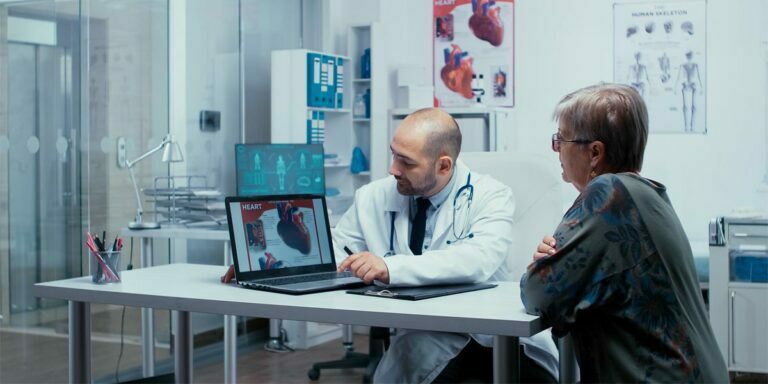In the United States, cancer is the leading cause of morbidity and mortality, with 1,806,590 new cancer diagnoses and 606,520 cancer deaths per year. Cancer care has a large influence on the health sector due to high rates of emergency department use and unplanned hospital admissions. Cancer treatment expenses are more than four times greater[1] than treatments for other common health problems, and the cost of cancer care in the United States is expected to exceed $245 billion by 2030.
Health systems are becoming increasingly innovative with how they manage cancer patients in order to lower overall cost of care, increase patient satisfaction, and manage symptom exacerbations. To bring care management into the patient’s home, many are turning to remote patient monitoring and telehealth oncology.
Remote Patient Monitoring on Cancer Patient in Chemotherapy
Cancer patients face a variety of issues as a result of chemotherapy treatment. To deal with the probable side effects of chemotherapy, an individual must first learn what to expect. Discomforts during chemotherapy can be a symptom or a side effect and are not the same thing. Symptoms are discomfort caused by the cancer, and a side effect refers to the unintended consequences caused by the chemotherapy. Symptoms and side effects must be investigated and addressed regardless of the cause. Common symptoms such as pain, exhaustion, loss of appetite, dehydration, nausea, vomiting, constipation, diarrhea, anxiety, and depression can now be easily documented by remote patient monitoring due to technological advancements. Symptoms can be tracked in real time using a controlled tablet, bluetooth-enabled peripheral devices, and modified survey capabilities of wireless devices.
Furthermore, instructional materials can be presented to the patient successfully via remote patient monitoring platforms, informing the patient of their clinical state and treatment plan, reducing anxiety and improving self-management. Remote patient monitoring can provide a safety net for patients who are having trouble at home but do not want to bother the respective care team or make an in-person appointment.
The latest development in oncology with remote patient monitoring is the implantable chemo-port catheter. It is a medical device that allows doctors to monitor cancer patients at home. The device can track patient response via microelectronic sensors to remotely monitor the early onset of complications. During chemotherapy, it can alert clinicians to changes in heart function, oxygen levels, blood cell counts, and other clinical markers.
Chemotherapy-induced immunosuppression makes cancer patients more vulnerable during this pandemic. Outpatient visits can be reduced with remote patient monitoring. Some patients must travel significant distances for their medical appointments. Providing cancer patients with remote patient monitoring can reduce the frequency of hospital visits. The patient’s condition can be monitored remotely by the care team, avoiding the need for the patient to travel to the specialist center. Both the patient and the hospital can save time, effort, and resources with the use of remote patient monitoring.
Remote Patient Monitoring on Cancer Patients in Remission
According to the International Agency for Research on Cancer, there were 18.1 million new cancer diagnoses and 9.6 million cancer-related deaths worldwide in 2018. According to a global monitoring report, some malignancies are evolving into chronicity, indicating a trend toward increased survival.[2] Cancer remission is defined as the absence of active illness for at least one month. The absence of active disease does not imply that cancer has been cured or that no symptoms of malignancy are present.
Patients in remission face a vulnerable period after discharge from the hospital, which leads to frequent unplanned readmissions or emergency visits. Uncontrolled symptoms are one of the most common causes of emergency visits among cancer patients. Overall, between 17% and 50% of cancer patients’ emergency room visits are deemed avoidable. Strategies to anticipate and prevent emergency visits in cancer patients are available. While intensive care is available in a hospital setting, due to a lack of resources, continuous monitoring and care in an outpatient setting is frequently preferable. As a result, unique and innovative solutions are required.
The use of smartphones and sensor-equipped devices allows objective patient-related metrics to be obtained in an unobtrusive, continuous, and real-time manner. Many diseases and patient groups have been studied using mobile health technologies, and cancer patients are included as a priority due to the vulnerability of this group to infectious diseases. Basch et al. reported a five-month overall survival benefit in patients receiving chemotherapy for metastatic cancer on mobile health technology for remote patient monitoring for health status.[3] Ferriolli et al. found a strong correlation between accelerometer findings and daily physical and functional status, fatigue, and quality of life in cancer patients at various stages of disease.[4]
A few researchers have looked into the use of remote patient monitoring using mobile health technologies to forecast the health status of cancer patients. Most of them use pedometers or accelerometers that solely count steps to predict functionality. Links were noted between daily physical activity, functional status, and the intensity of symptoms in these studies.[2]
Remote Patient Monitoring on Cancer Patient in End of Life
The end of life is the time when many therapy and care decisions for cancer patients are made. The end of life for cancer patients could take months, weeks, days, or hours. It is critical for family and healthcare practitioners to be aware of the patient’s desires ahead of time and to discuss end-of-life arrangements openly with the patient. This will make crucial decisions for the patient’s care towards the end of life easier for family members. When treatment options and plans are addressed with the patient and family members before the end of life, it can reduce stress for both the patient and the family. End-of-life planning and decision-making should begin soon after a cancer diagnosis and continue throughout the course of the disease. Having these decisions written down can help both the family and the healthcare staff understand the patient’s desires.
Family and friends play a crucial role in cancer treatment. They, like the patient, have shifting requirements. Many caregivers grow overwhelmed as a result of the additional tasks imposed on them. Many people find it difficult to care for a sick loved one while also juggling other responsibilities such as job, housework, and family responsibilities. Uncertainty about how to assist a loved one with medical conditions, a lack of social support, and feelings like anxiety and dread can all contribute to caregiver stress. Remote patient monitoring can aid these patients and family members to find the most compassionate, humanistic, and comfortable means to live out their lives. Remote patient monitoring is a powerful new approach to improve patient and caregiver experiences while lowering the total cost of what may be a very expensive phase of one’s life. The utilization of remote patient monitoring enables an integrated, digital health-driven care-management system that can oversee these patients “24/7” in the comfort of their own homes, which can greatly lessen the burden of family members and caregivers.
During a global pandemic marked by inpatient bed, ventilator, and PPE shortages, the remote patient monitoring program proved to be an effective outpatient clinical management strategy for patients that were terminally ill. This care paradigm allowed for simultaneous mitigation of the elevated hazards of exposure, transmission, and resource use associated with traditional care.
Patients who are terminally ill and who reside in rural areas with limited access to care can benefit greatly from remote patient monitoring. These patients can receive care despite limited access to resources. They can also receive tailored interventions and necessary care while enjoying the convenience of staying at home. These advantages are especially beneficial to patients who live in rural places and would prefer to get care and monitoring at home.
Takeaway
Cancer is a complicated disease that frequently necessitates a combination of treatments from a range of health specialists over a long period of time. This complicates healthcare delivery and makes it difficult for health-care providers in hospitals and communities to collaborate effectively to provide high-quality, coordinated patient care. The need for strategic improvements in cancer care coordination, particularly given the rising demand on cancer resources and services as a result of greater cancer incidence rates, improved detection, treatment, and survival rates. Remote patient monitoring technology allows cancer patients to have more access to care. Remote patient monitoring has the ability to improve both quality of care and gives patients with extended levels of education, support, and feedback, as compared to traditional healthcare models.
References:
- Cancer Care Costs | AACR | News Releases. (2020, June 10). American Association for Cancer Research (AACR). https://www.aacr.org/about-the-aacr/newsroom/news-releases/cancer-care-costs-in-the-united-states-are-projected-to-exceed-245-billion-by-2030/.
- Joshua C. Pritchett et al., Association of a Remote Patient Monitoring (RPM) Program With Reduced Hospitalizations in Cancer Patients With COVID-19,JCO Oncology Practice, 2021
- Basch E, Deal AM, Dueck AC, et al.: Overall survival results of a trial assessing patient-reported outcomes for symptom monitoring during routine cancer treatment. JAMA 2017;318:197–198. Crossref, Medline, Google Scholar
- Ferriolli E, Skipworth RJE, Hendry P, et al.: Physical activity monitoring: A responsive and meaningful patient-centered outcome for surgery, chemotherapy, or radiotherapy? J Pain Symptom Manage 2012;43:1025–1035. Crossref, Medline, Google Scholar








